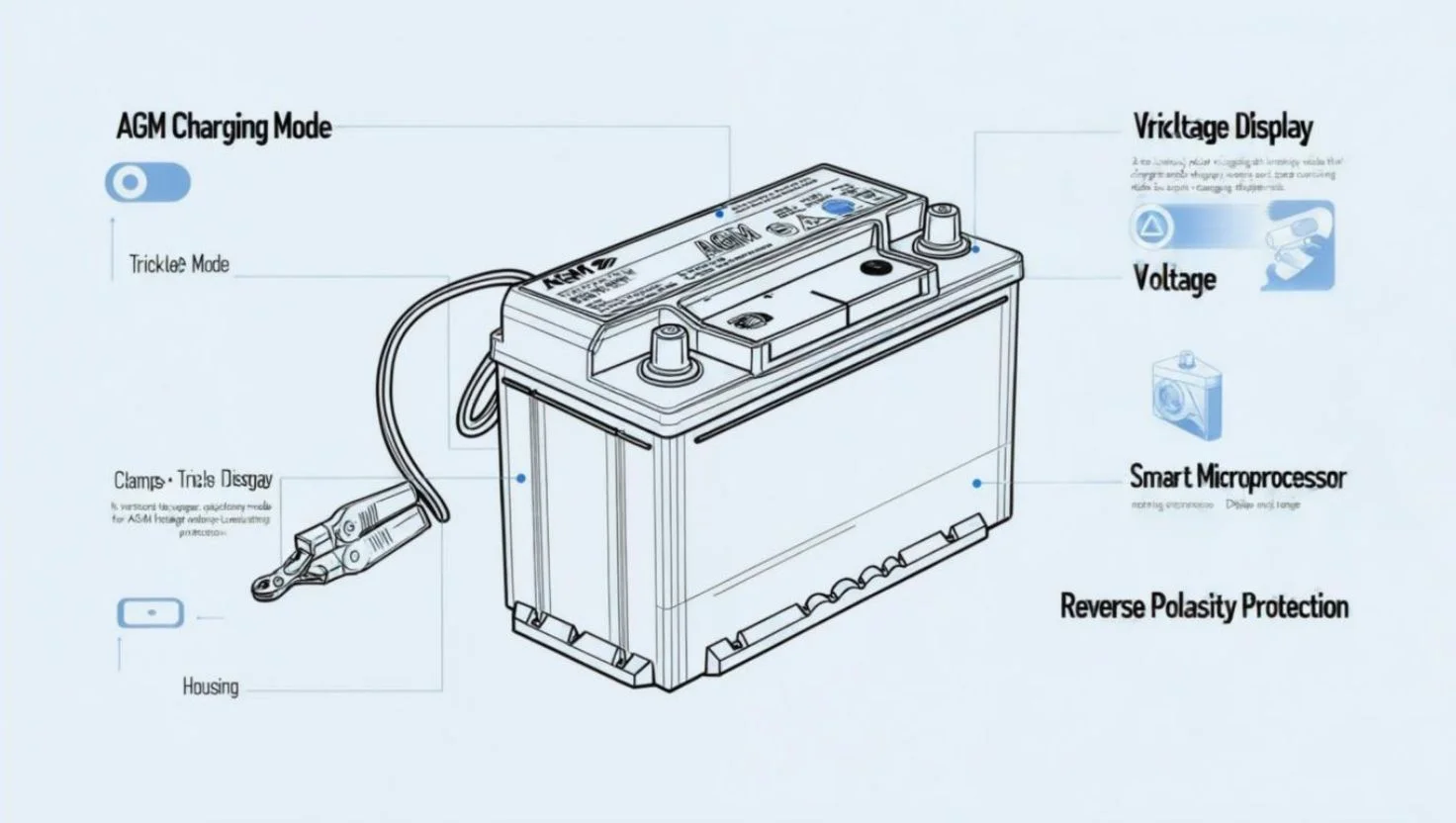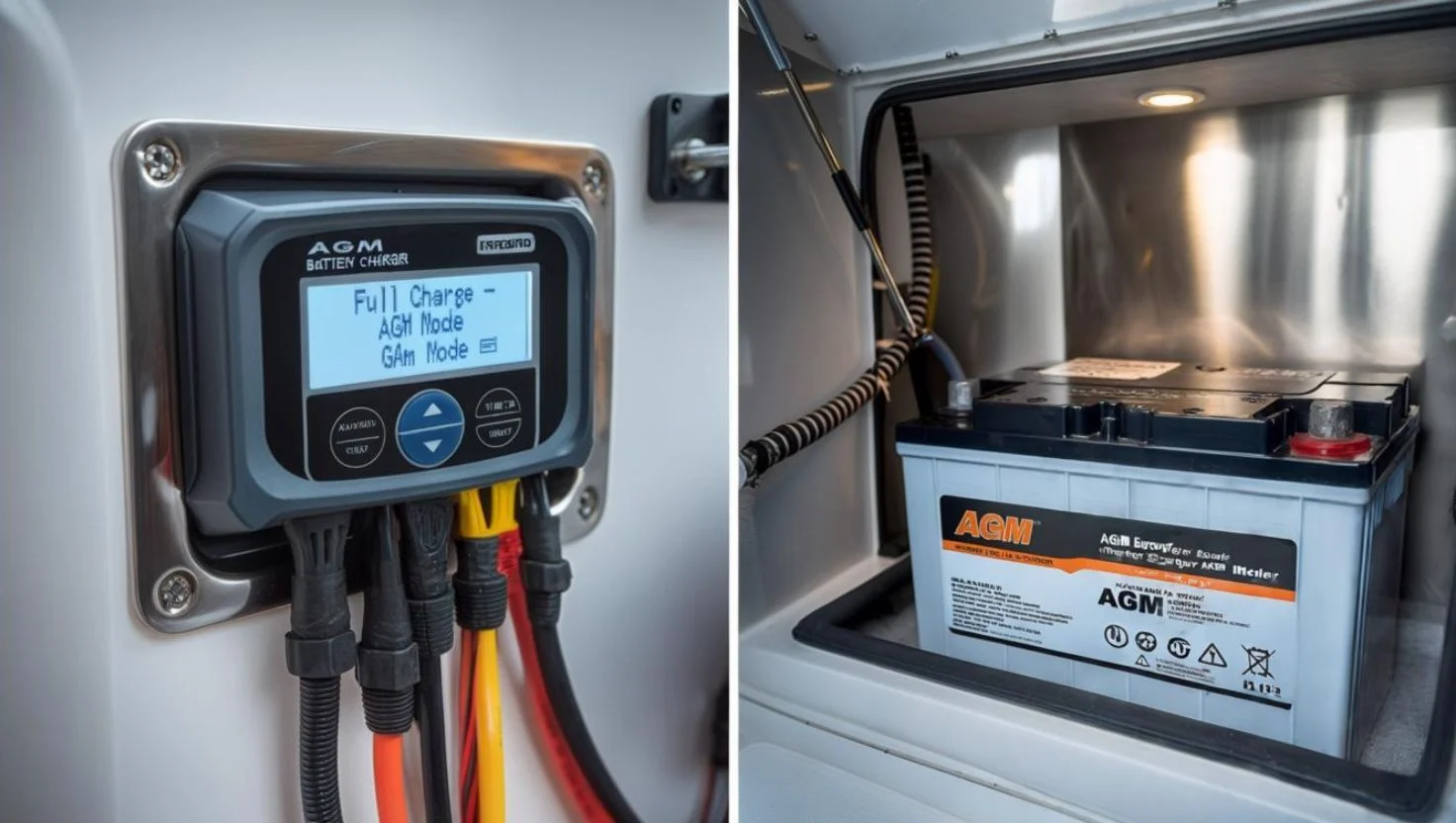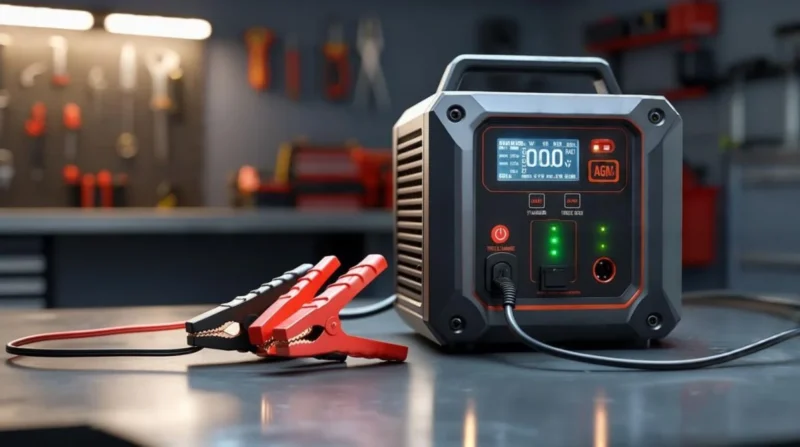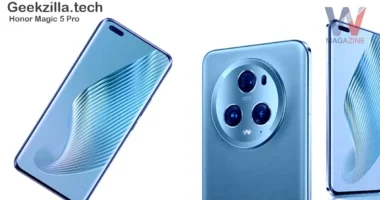Table of Contents
- What Makes AGM Batteries Special?
- Why You Need an AGM-Compatible Charger?
- Steps to Choose the Right Charger
- Charging Process: Step by Step
- Common Mistakes & How to Avoid Them
- Choosing the Best Charger for You?
- Battery Charger for AGM Battery vs. Regular Chargers
- What Is an AGM Battery?
- Regular Battery Chargers: Basic and General Use
- AGM Battery: Smart, Safe, and Specific
- Key Differences at a Glance
- Conclusion
Choosing a battery charger for an AGM battery doesn’t need to be complicated. With AGM (Absorbent Glass Mat) batteries growing in popularity for cars, boats, solar setups, and backups, understanding how to charge them correctly will help you get the most life and performance from your investment.
What Makes AGM Batteries Special?
AGM batteries are sealed lead-acid (VRLA) batteries with electrolyte absorbed in fiberglass mats. This design gives them:
- Spill-proof and shock-resistant construction.
- Deep-cycle ability, they handle repeated discharges well.
- Low self-discharge rates provide long shelf life.
However, AGM batteries are sensitive to charging. Using the wrong charger or settings can lead to overheating, sealed-valve venting, and permanent damage.
Why You Need an AGM-Compatible Charger?
Not all chargers are created equal. A quality smart charger designed for AGM batteries offers:
- AGM-specific charging mode with correct voltage phases.
- Multi-stage charging: bulk, absorption, and float stages.
- Temperature compensation to protect battery health.
Avoid using one-size-fits-all chargers they often use generic algorithms that don’t suit AGM batteries.
Steps to Choose the Right Charger
Look for AGM / Absorbed Setting
Always pick a charger labeled AGM or Absorbed Glass Mat. This guarantees that AGM batteries receive the correct voltage levels during charging.
Choose the Right Amp Rating
Match charger amps to battery capacity (Ah). Select a charger that delivers 10–20% of the battery’s amp-hour rating, with an upper limit of 30% to prevent strain.
For example, a 100Ah AGM battery performs well with a 10–20A charger, while 30A is the highest safe current you should use.
Prioritize Smart (Multistage) Chargers
Smart chargers adapt as the battery fills:
- Bulk Constant current to ~80%.
- Absorption Constant voltage, current tapers off.
- Float maintains full charge. These stages prevent overcharging and maintain battery health.
Temperature Compensation
Choose chargers with built-in temperature sensors or compensation features. The charging voltage must be adjusted based on the surrounding temperature to prevent overcharging or insufficient charging.
Check for Safety Features
Priority features include reverse polarity protection, spark prevention, and thermal safeguards. Charging should occur in a ventilated area while wearing gloves and eye protection.
Charging Process: Step by Step
- Inspect the battery for damage and ensure the ventilation area.
- Disconnect negative terminal (if on vehicle).
- Mount the charger and select AGM mode + correct voltage (typically 12 V).
- Connect red to +, then black to –.
- Plug in and begin charging smart charger will manage stages.
- Wait through all stages until it enters float/maintenance mode.
- Turn off and disconnect the charger, negative cable last.
- Store battery in a cool, dry place.
Use this formula: Time ≈ Battery Ah ÷ Charger Amps + 10–20% extra for topping off, for example:
-
- 70 Ah battery with 5 A charger → ~14 hours + float time.
- A 10 A charger cuts that to ~7 hours.
- Max amperage shouldn’t exceed ~30% of the Ah rating.

Common Mistakes & How to Avoid Them
- Overcharging: Using the wrong setting or too much voltage can vent the AGM valve and dry it out.
- Undercharging: It can cause sulfation and capacity loss.
- Wrong mode: Avoid using fast charge or trickle modes incorrectly.
- Neglect: Don’t leave charging unattended or in extreme temperatures.
Choosing the Best Charger for You?
When buying, consider your needs:
- For occasional use or slow charging, use a smart AGM charger with 2–5 amps.
- For bigger batteries or quicker charging, use a charger with 10–20 amps.
- Or solar, marine, or backup systems, use a professional AGM charger that adjusts for temperature.
Trusted brands include NOCO Genius (10 A smart charger), Victron Energy, and other chargers with “AGM” mode.
Battery Charger for AGM Battery vs. Regular Chargers
When it comes to charging your batteries, choosing the right charger is extremely important, especially if you’re using an AGM battery. Many people think that all chargers are the same, but that’s not true. AGM (Absorbent Glass Mat) batteries have different needs compared to traditional flooded lead-acid batteries, and charging them incorrectly can lead to reduced performance or even permanent damage.
To help you make the right choice, let’s explain the main differences between a battery charger for AGM batteries and a regular charger in clear and simple terms.
What Is an AGM Battery?
An AGM battery is a type of sealed lead-acid battery. Unlike regular flooded batteries that have liquid electrolyte, AGM batteries hold the electrolyte in fiberglass mats between the battery plates. This design makes them:
- Spill-proof and leak-resistant.
- Better at handling deep discharges.
- More resistant to vibration and cold.
- Maintenance-free.
But because of this sealed and sensitive structure, charging AGM batteries the wrong way can damage them over time.

Regular Battery Chargers: Basic and General Use
Regular chargers (also known as standard or manual chargers) are usually made for older, flooded lead-acid batteries. These chargers:
- Deliver a constant current or voltage.
- Often lacks smart sensing.
- Don’t adjust output based on battery type or condition.
- May overcharge or undercharge AGM batteries.
They work fine for some traditional batteries, but they’re not precise or safe enough for modern AGM batteries.
AGM Battery: Smart, Safe, and Specific
A battery charger for AGM batteries is designed to handle the unique charging needs of AGM batteries. These chargers usually include:
- AGM mode or selectable battery type setting.
- Smart charging technology that monitors battery condition.
- Multi-stage charging (bulk, absorption, float).
- Temperature compensation for safer charging in different weather.
- Automatic shut-off to prevent overcharging.
This helps maximize battery life, improve performance, and reduce risks.
Key Differences at a Glance
| Feature | AGM Battery Charger | Regular Charger |
|---|---|---|
| Battery Type Compatibility | Designed for AGM, gel, and lead-acid | Usually, for flooded lead-acid only |
| Charging Control | Smart/multi-stage | Constant, less controlled |
| AGM Mode | Yes | Rarely |
| Overcharge Protection | Yes – auto shutoff or float mode | Sometimes, but not always |
| Temperature Compensation | Often included | Typically not included |
| Battery Life Impact | Preserves and extends battery life | Can shorten the life of AGM batteries |
Conclusion
Always pick a charger labeled AGM-compatible. Use a charger rated at 10–20% of battery Ah. Choose a smart multi-stage charger. Ensure temperature compensation and safety features. Monitor charging to avoid under- or overcharging. With the right charger and care, your AGM battery will deliver years of reliable service. Choosing the right charger for an AGM battery is crucial. Choose wisely and you’ll protect your battery’s health and performance and save money over time.









